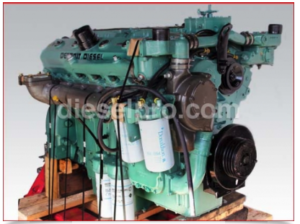December 18, 2024
Removing the Cylinder Head For Detroit Diesel V71 Engines
Preparation
Loosening Bolts
Lifting the Head
Inspection and Cleaning
Reassembly of the Cylinder Head
Installing New Valve Seat Inserts
Reinstalling Valves, Springs, and Rocker Arms
Install Valves
3. Install Valve Springs
Final Inspection
4. Torque Rocker Arms
Step-by-Step Procedure:
Replacing Injector Tubes
Reinstalling the Cylinder Head
Compression Gasket Installation
Tightening Sequence and Torque Specifications
Post-Installation Check
Read More
December 18, 2024
1. Replacing Valve Seat Inserts For Detroit Diesel 6V71, 8V71, 12V71, 16V71
Why It’s Necessary
Step-by-Step Process
2. Extract the Worn Inserts
3. Clean the Seat Bore
4. Install New Inserts
5. Lap the Valves (If Using Used Cylinder Head)
Final Steps
2. Replacing Fuel Injector Tubes For Detroit Diesel V71 Engines (6V71, 8V71, 12V71, 16V71)
Why It’s Necessary
Step-by-Step Process for Replacing Fuel Injector Tubes
Maintenance Tips for Fuel Injector Tubes
3. Checking and Maintaining Coolant Passages For Detroit Diesel V71 Engines (6V71, 8V71, 12V71, 16V71)
Why It’s Necessary
Step-by-Step Process for Checking and Maintaining Coolant Passages
Inspect for Damage
Maintenance Tips for Coolant Passages
4. Inspecting and Replacing Valve Components For Detroit Diesel V71 Engines (6V71, 8V71, 12V71, 16V71)
Why It’s Necessary
Step-by-Step Process for Inspecting and Replacing Valve Components
1. Remove the Valves
3. Replace Valve Seals
4. Reassemble Components
Maintenance Tips for Valve Components
5. Pressure Testing the Cylinder Head
6. Cleaning and Preparing the Cylinder Head
Additional Notes
Read More

December 18, 2024
Design Overview: Valve Layout, Injector Configuration, and Cooling System Integration
Cylinder Head Design For Detroit Diesel V71 Engines (6V71, 8V71, 12V71, 16V71):
Components of the Valve and Injector Operating Mechanism
3. Valve Bridges:
Cooling System Integration
Advanced Design Features
Maintenance and Serviceability
Common Maintenance and Repair Needs for the Detroit Diesel V71 Cylinder Head
Routine Cylinder Head Maintenance and Repairs
1. Replacing Valve Seat Inserts
2. Replacing Fuel Injector Tubes
3. Checking and Maintaining Coolant Passages
Step-by-Step Cylinder Head Removal, Inspection, Cleaning, and Reassembly
1. Removing the Cylinder Head
Cylinder Head Weights for Detroit Diesel V71 Engines
2. Inspection and Cleaning
3. Reassembly
Replace Injector Tubes:
Important Notes:
Reinstall the Cylinder Head On Detroit Diesel V71 Engines:
Important Notes:
Compression Gasket Installation
Tightening Sequence and Torque Specifications
1. Tightening Sequence
2. Torque Specifications
Tightening Procedure:
3. Final Checks
Best Practices for Cylinder Head Maintenance
Read More

December 18, 2024
Introduction to Refurbishing Detroit Diesel Cylinder Blocks
Disassembly and Preparation
Preliminary Steps
Cleaning Procedures
Inspection Process
Visual Inspection
Dimensional Measurements
Pressure Testing
Machining and Repairs
Cylinder Bores
Deck Surface
Main Bearing Bores
Crack Repairs
Assembly and Testing
Preassembly Steps
Installation
Post-Assembly Testing
Conclusion
Read More
December 18, 2024
Structural Role and Design of the Cylinder Block
1. Structural Integrity
2. Cylinder Configuration and Features
3. Cooling Variations
Cleaning, Inspection, and Pressure Testing
1. Cleaning the Cylinder Block
2. Inspection for Damage or Wear
3. Pressure Testing
Step-by-Step Instructions for Disassembly and Reassembly
1. Disassembly of Components
2. Reassembly of Components
Cylinder Liner and Bore Measurements
1. Measuring Cylinder Bore
2. Cylinder Liner Specifications
Torque Specifications for Bolts, Studs, and Plugs
1. Main Bearing Bolts
2. Cylinder Head Bolts
3. Freeze Plugs
4. Oil Gallery Plugs
Best Practices for Cylinder Block Maintenance
Read More
December 18, 2024
Importance of Proper Operation and Maintenance
Prolonged Engine Life:
Optimal Performance:
Reduced Operating Costs:
Environmental Compliance:
Safety Assurance:
Recommended Tools and Safety Precautions
Essential Tools for Maintenance and Repairs
Safety Precautions During Maintenance
Wear Proper Safety Gear:
Work in a Well-Ventilated Area:
Handle Fluids Safely:
Secure the Engine:
Disconnect Power Sources:
Overview of Inspection and Cleaning Best Practices
Routine Inspections
Visual Inspections:
Lubrication System:
Cleaning Best Practices
Use the Right Cleaning Agents:
Choose cleaning solvents that are compatible with engine components and environmentally safe. Avoid harsh chemicals that may damage seals or gaskets.
Focus on Key Areas:
Avoid Contamination:
Clean as You Disassemble:
Inspect After Cleaning:
Establishing a Maintenance Schedule
The Role of Preventive Maintenance
Conclusion
Read More




 Free US Calls: 1-888-433-4735
Free US Calls: 1-888-433-4735 International: 305-545-5588
International: 305-545-5588



